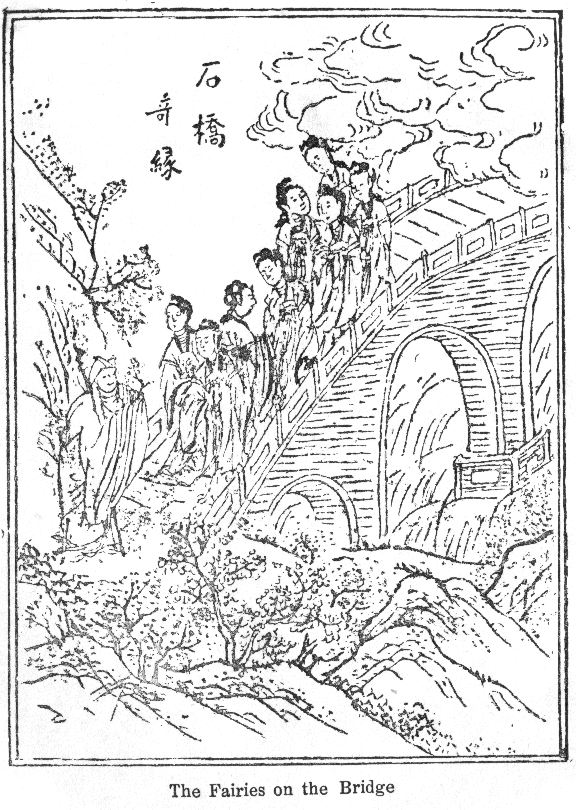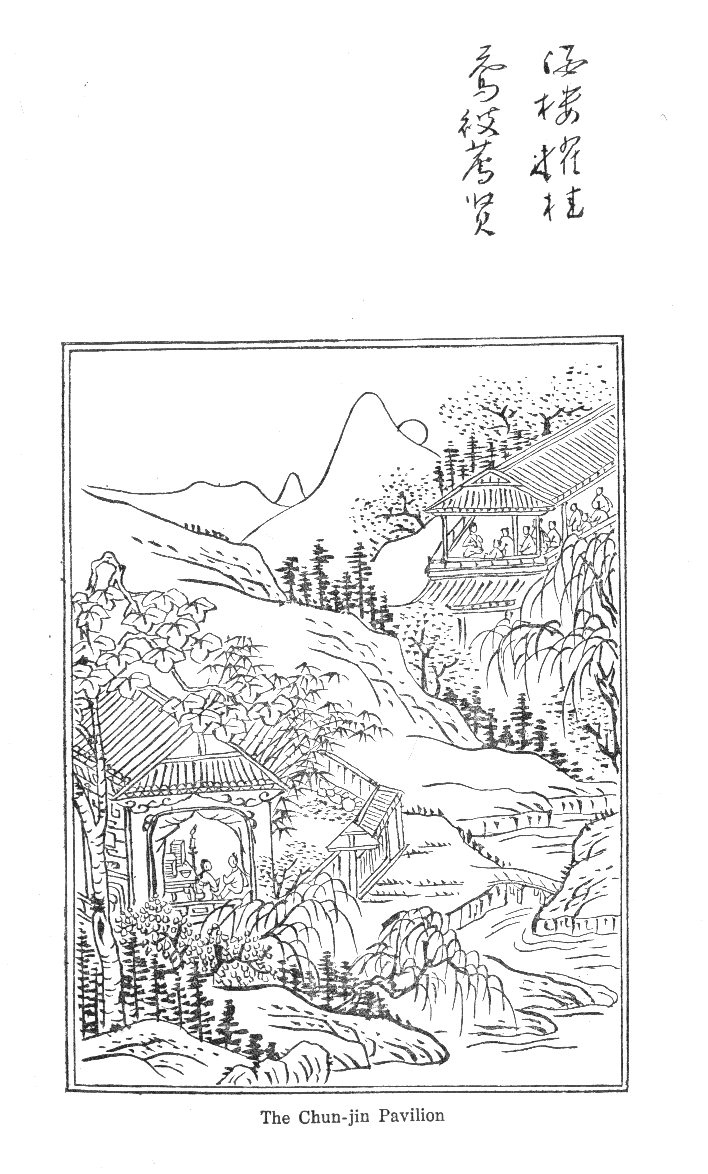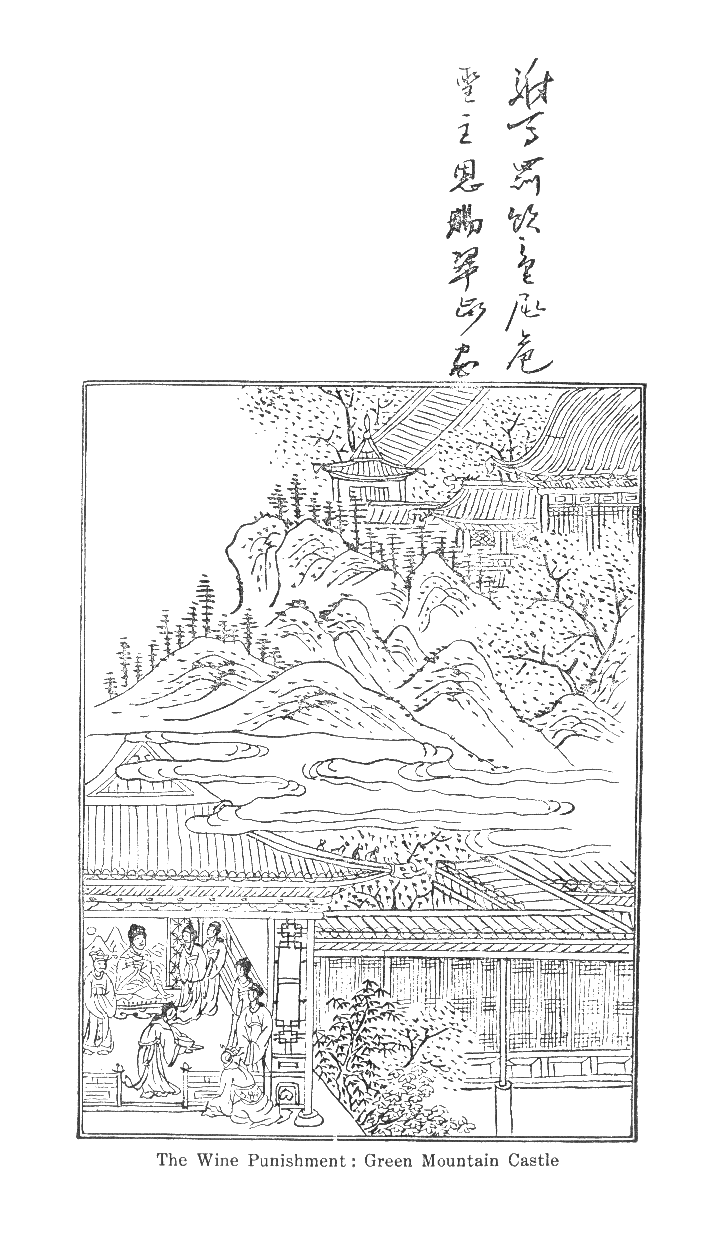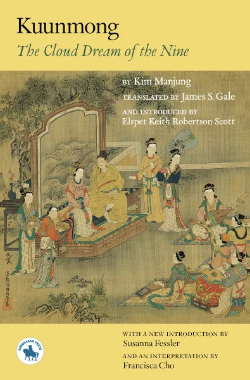A very popular literary text in South Korea, Kim Manjung’s novel Kuunmong begins with the tale of a Buddhist monk who fails in his religious duties: he meets a group of nine gorgeous fairies at a bridge and finds himself tempted by their beauty, which he later confesses to an abbot. The remainder of the book tells of his “punishment”: in his next life, he is to be reborn into the world as a superior man, outstanding in every way.
In this, the author spares us no extravagance: the hero, Yang So-Yoo, constantly is described by others as handsome, and by the age of fifteen he masters geomancy, astrology, and military strategy. Throughout his wanderings and adventures in China, he demonstrates his prowess at everything from military strategy to music, poetry, and disguise. He collects a group of nine brides, each of which is one of the fairies who tempted him, now in similarly gorgeous human form, and yet, in the end, he still feels that there’s something missing.

As you can guess—this being a religious novel—the something that’s missing has to do with Buddhist theology, but I won’t spoil it for you. I will note that there are several translations out there: the most widely available are James Scarth Gale’s 1922 translation (recently reprinted by Kurodahan as Kuunmong: The Cloud Dream of the Nine) and Heinz Insu Fenkl’s translation The Nine Cloud Dream (2018). Fenkl’s translation is more faithful to the original, but Gale’s has a charming archaism to it, and it’s also the translation that is available in the public domain from several sources online.
So, what inspiration can this book serve for an RPG game?
The first is just as inspiration for the literary culture of your NPCs. Having a new novel released that everyone literate is reading can be a fun bit of detail in a campaign. Your players might assume it’s an evil tome that needs to be stamped out at first—especially if they’ve played a lot of Call of Cthulhu—but soon they’ll get the idea. It can be fun to have NPCs try to chat with them about the novel, soliciting opinions and then slowly realizing the player characters haven’t read the book and have no idea what it’s about. (Even more fun if they encounter the author and are forced to talk about the book with him or her.)
Next, the narrative structure of Kuunmong would work well as a kind of “campaign break”: if you’re hitting that point in the game where your players, or you, feel like it’s a natural place for a break or a big shift in campaign tone, follow Kuunmong’s example. Simply have the characters stray into the cave of a high-level monk or spellcaster who en-spells them to sleep and dream (seemingly for eternity). Then have them roll up high-level characters—or 1st level ones, if you prefer—and run them through some adventures of a very different tone than the one you’d previously been running.

That is to say, if you were running a picaresque adventuring game, switch to courtly intrigue; if you were doing pastoral heroism, switch to a horror tone. You could even use this framing device as a way of sending characters into the past or future of the setting, always a great way to justify a serious change in tone. Instead of a didactic purpose, you could have the characters uncover well-hidden or forgotten secrets of the world. Alternately, if they embark upon this dream at a particularly desperate moment in the campaign, they could garner leads to the McGuffin they need to prevent the end of the world, or the victory of the villain, or whatever.
Next, though the “reincarnation” angle in the novel isn’t what it first seems, there’s nothing stopping you running a game where player characters reincarnate, generation after generation, constantly fighting against the same evil mage or cabal who wants to ruin the world. You could even allow characters to retain some of their previous class abilities in future reincarnations, if you think it would add to the game. (If this appeals, I also recommend checking out the Mahabharata; while it’s an Indian epic, rather than a Korean one, it’s a great reference for how to dramatize reincarnation in an epic setting.)

Lastly, there’s a final, and much more ambitious use to which you could put Kuunmong as an in-world text: you could literally grab a copy of the text from one of several online sources (Gale’s translation is in the public domain) and edit it into an in-world text, adding adventure leads, references (direct or elliptical) to NPCs and places of interest, seeding it with hints about where certain treasures can be found and what horrors guard them. In this case, it’s best for the novel to be something that is, in-world, posthumously published by an author who is not responding to necromantic requests for clarification. (The “death of the author” indeed!)
It’d be a lot of work, but for the right group of players, it could also be a springboard for potentially years of campaigning. If you are considering this path, your best model is Pelgrane Press’ Dracula Dossier campaign, which uses an expanded, “unredacted” version of Bram Stoker’s novel Dracula to the same purpose.
Finally, since the book is in the public domain, a free online version of the Gale translation that is ready for your edits and modifications (along with the illustrations that accompanied the text in its original publication, which are reproduced above) is available at ibilio.org.
You can find the Gale Translation on Amazon and the Heinz Insu Fenkl Translation on Amazon
and the Heinz Insu Fenkl Translation on Amazon as well.
as well.
